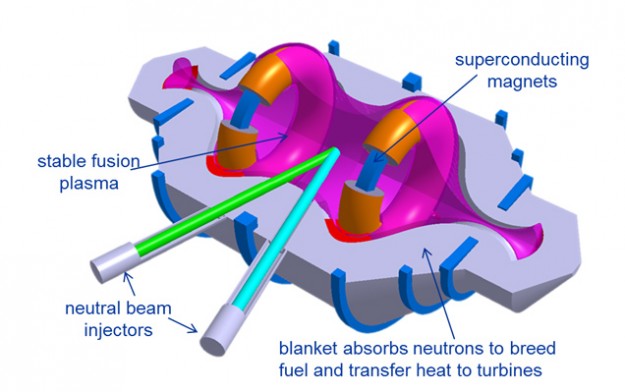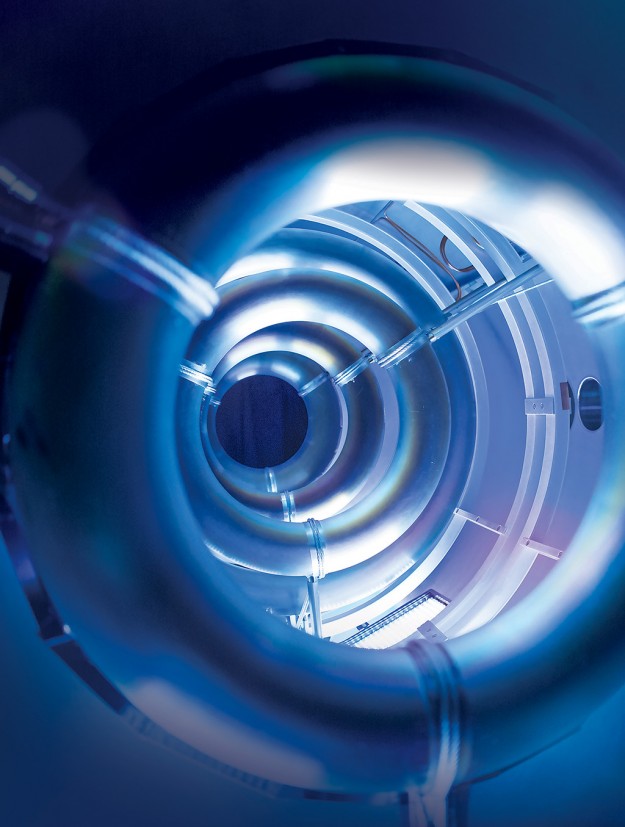On October 15th, Aviation Week received exclusive access to Lockheed Martin’s Revolutionary Technology Programs unit; specifically regarding a new Compact Fusion Reactor (CFR) program lead by Aeronautical Engineer Thomas McGuire. McGuire and his team make a claim that uses a lot of phrases like “holy grail” and paradigm-shifting. How compact? The containment vessel in test unit is said to be roughly the equivalent of a business jet engine. “I studied this in graduate school where, under a NASA study, I was charged with how we could get to Mars quickly,” McGuire said in the article.
If true, this may ultimately be the answer to planetary energy needs within twenty years. With the initial testbed dimensions expected to just about fit on a truck bed. I know its larger and probably of too high an output to compare to, say a CoreTek 275 XL engine, but can power a small city of 100,000 people all by itself at one hundred megawatts. And this is just a working testbed due within the decade. This isn’t some guy tinkering in his garage in his spare time either, this is the Skunkworks; Lockheed Martin’s go-to gang of whizkids.

Compact Fusion Reactor cross-section. Pretty much looks the way I remember their BattleTech equivalents work.
“Our compact fusion concept combines several alternative magnetic confinement approaches, taking the best parts of each, and offers a 90 percent size reduction over previous concepts,” said in an official statement on the Lockheed Martin website.
Naturally, with such a compact power plant compared to the old Soviet Tokamak-style units which were the size of the largest class of fission reactors, the (CFR) Fusion plant is ideal for larger vehicles. This could mean aircraft and submarines that don’t need to refuel, spacecraft with massive acceleration potential, even ‘lightweight, ‘pocket’ generators for powering colonies on the Moon, Mars, and beyond.
This video from the Lockheed Martin website explains a bit of how the new CFR power plant operates and the principle behind nuclear fusion. The problem with the old building-sized tokamak generators is that despite their size they had very little room for plasma generation within the containment vessel. This plasma is several hundred times hotter than the boiling point of steel, and as described in the description page for the BattleTech technology equivalent, requiring a strong magnetic field to keep the plasma contained. Instead of using tubular rings to create this magnetic containment bottle, a series of superconducting electromagnetic coils are used. According to McGuire- “instead of a bike tire expanding into air, we have something more like a tube that expands into an ever-stronger wall.” The brass of it is ten times the power of a tokamak with a ninety percent reduction in unit size. Plus they solve the efficiency issues from previous projects.

Inside of the CFR mockup showing the arrangement of the superconducting EM field coils
I won’t try to pretend to really know how it works. What matters to me is that it works at all. And more to the point, what it could mean to energy concerns on the planet- and space colonization and exploration beyond Earth. If someone eventually builds a Star Destroyer or a Texas class cruiser with one, well it’s probably inevitable at this point given human nature. We look to be poised to be able to step out among the stars soon-perhaps within the century if we’re lucky. I just hope the good we bring along outweighs the bad,
Let’s hope we don’t blow each other up before we can hurl ourselves into space and blow each other up.
Well bargained, and done.
Sounds very cool, and potentially revolutionary. I do wonder about expense though…
Actually, if the comments in TM are to be believed about finger myomers in battlemechs being multi-Kilowatt motors … and that the leg myomers combined with nefber’s calculations on the BT fusion engines in aerospace fighters … hundred megawatt might be in the near to right range for a ‘mech.
There’s also the MASSIVE e-warfare sucking up who knows how many thousands or possibly a million or more watts. Remember, certain command mechs are capable of virtual world-wide communications; I would guess that when they don’t have sat uplinks they do this by using freqs that bounce off of the planetary atmosphere, and our past and current transmitter installations that do this are up in the hundreds of thousands of watts. I think there might have even been a megawatt (transmit power, that means more than a megawat injected into the antenna/array) transmitter.
Be very interesting to see if this pans out – but the thought of having to get trained up on how to handle irradiated fusion engine cores from cars is kind of scary. You can imagine the mess from a bad car or train accident, dumping irradiated core parts and irradiated coolant all over the place.
Hi guys,
While that whole CFR things looks great on paper, and will likely work as advertised, the only group that will see it for a long time are government agencies. Reason? Oil lobbies are too rich and powerful to allow that tech into the hands of the commoners/freeborn.
I guess you have be a MechWarrior to have a chance at seeing it up close.